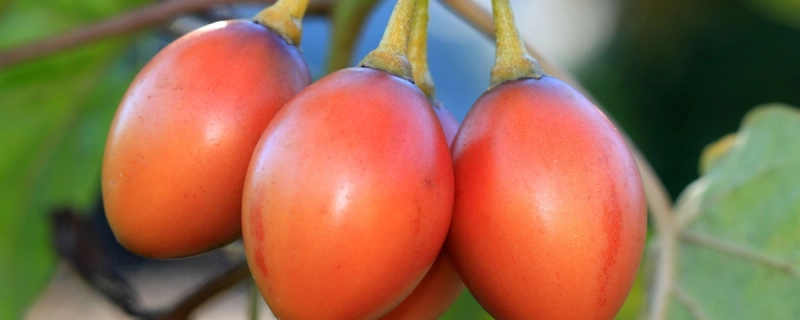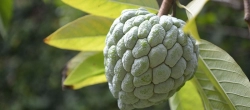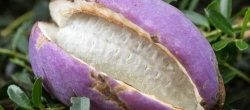Tamarillo (Solanum betaceum): Taste Profile, Aroma, Benefits and Health Risks
Tamarillo (Solanum betaceum), commonly referred to as the tree tomato, is a small, oval fruit native to South America, particularly the Andean regions of Ecuador, Colombia, Peru, and Bolivia. It belongs to the nightshade family (Solanaceae) and is known for its vibrant red, orange, or yellow skin and its tangy, tomato-like flesh. While it resembles a small tomato, tamarillo has a distinctively bold flavor, making it a versatile ingredient in both sweet and savory dishes.
Tamarillo (Solanum betaceum), also known as the tree tomato, is generally safe for consumption. However, as a member of the nightshade family (Solanaceae), it may cause allergic reactions in individuals sensitive to tomatoes, eggplants, or potatoes. Its skin contains bitter alkaloids that can cause mild digestive discomfort if consumed in large quantities. Pregnant women should consume tamarillo in moderation due to its acidity and potential impact on digestion.
What does Tamarillo (Solanum betaceum) taste like?

Complete Sensory Description
Taste
Tamarillo has a unique combination of sweet, tart, and slightly bitter flavors. The pulp is tangy and refreshing, with hints of passion fruit, kiwi, and tomato. The seeds and surrounding gel have a milder sweetness, while the skin is notably bitter, which is why it is usually removed before consumption.
Aroma
The aroma of tamarillo is fruity and slightly herbal, with mild tropical and citrus undertones. When sliced open, it releases a fresh, tangy scent that enhances its appeal.
Texture
The flesh of tamarillo is smooth and juicy, with a soft, jelly-like center containing numerous edible seeds. The skin is firm and slightly waxy, though it is typically not eaten due to its bitterness.
Appearance
Tamarillo is an egg-shaped fruit, typically 4 to 10 cm in length, with a thin, smooth skin that ranges in color from deep red to bright orange or golden yellow. The inner flesh varies as well, with red-skinned varieties having a darker, more intense hue and yellow-skinned ones being milder in color and flavor.
In-depth Flavor Analysis
Tamarillo’s tartness comes from natural citric and malic acids, while fructose and glucose provide mild sweetness. Alkaloids and phenolic compounds in the skin contribute to its bitterness. Volatile compounds responsible for its aroma include esters and aldehydes, which enhance its fruity and slightly herbal notes. Cooking or sweetening tamarillo reduces its acidity and enhances its natural sugars, making it more suitable for desserts and sauces.
Varieties and Culinary Applications
Tamarillo has several color variations that influence its flavor:
- Red tamarillo is more acidic, tangy, and bold in taste.
- Orange and yellow tamarillo is milder, sweeter, and less astringent.
Common culinary uses include:
- Fresh consumption – sliced and eaten raw, often sprinkled with sugar or salt
- Juices and smoothies – blended into refreshing beverages
- Jams and preserves – cooked into spreads due to its natural pectin content
- Sauces and chutneys – combined with spices for savory dishes
- Desserts – incorporated into tarts, sorbets, and fruit salads
- Roasted or grilled – caramelizes the sugars, reducing acidity and enhancing sweetness
Selection and Storage
When choosing tamarillos, select fruits that are firm but slightly yielding to gentle pressure. The skin should be smooth and evenly colored, free from blemishes or cracks.
- Unripe tamarillos should be stored at room temperature until they ripen.
- Ripe tamarillos can be refrigerated for up to a week.
- Peeled or sliced tamarillo should be stored in an airtight container to prevent oxidation.

Nutritional Insights
Tamarillo is a nutrient-dense fruit with several health benefits, including:
- Vitamin C – supports immune function and skin health
- Vitamin A (beta-carotene) – promotes vision and cellular repair
- Potassium – regulates blood pressure and muscle function
- Fiber – aids digestion and supports gut health
- Anthocyanins and polyphenols – provide antioxidant and anti-inflammatory benefits
Expert Insights & Culinary Tips
- Peeling the skin before consumption removes bitterness and enhances the fruit’s natural sweetness
- Pairing tamarillo with dairy, such as yogurt or cream, balances its acidity
- Roasting or grilling caramelizes the natural sugars and reduces tartness
- Fully ripened tamarillo has a mellower taste, making it more suitable for sweet dishes
Interesting and Curious Facts
- Tamarillo was renamed "tree tomato" in New Zealand in the 1960s to distinguish it from regular tomatoes
- The fruit grows on small trees that can produce fruit for up to 12 years
- It is one of the few nightshade fruits that are naturally high in antioxidants
- In Colombia, tamarillo juice is a traditional drink known as jugo de tomate de árbol
Harm and Dietary Considerations
- The skin contains bitter alkaloids that may cause mild digestive discomfort if consumed in large amounts
- Its acidity may irritate sensitive stomachs or contribute to acid reflux if eaten excessively
- Some individuals sensitive to nightshade plants (Solanaceae) may experience mild allergic symptoms
- Pregnant women should consume tamarillo in moderation, as its acidity may cause digestive discomfort or reflux
Religious Dietary Considerations
Tamarillo is permissible in most religious dietary frameworks, including Hinduism, Islam, and Buddhism. There are no known restrictions associated with its consumption in major religious traditions.
Final Thoughts & Sensory Journey
Tamarillo is a bold and vibrant fruit that combines sweetness, tartness, and a hint of bitterness, making it a unique addition to both sweet and savory dishes. Its rich aroma, smooth yet juicy texture, and deep, fruity taste offer a dynamic culinary experience. Whether eaten fresh, blended into a juice, or cooked into a sauce, tamarillo provides a wide range of flavors for various applications.
Resources
- Journal of Food Science – Nutritional composition and antioxidant properties of tamarillo
- Handbook of Tropical Fruits – Culinary applications and preservation methods
- Ethnobotanical Studies of Andean Fruits – Traditional uses and medicinal benefits of tamarillo











